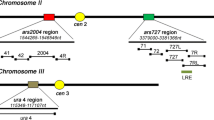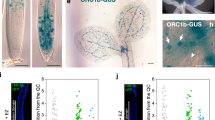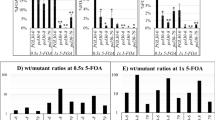Summary
A sequence that supports extrachromosomal replication of plasmids in yeast has been identified within the first intron of the human hypoxanthine-guanine phosphori bosyltransferase (HPRT) gene. This represents the first isolation of such an autonomously replicating sequence (ARS) from an exactly known position in the human genome. This ARS shares similarities of imparted yeast phenotype and DNA sequence with other heterologus ARSs. In addition, this sequence is found to be a matrix association region (MAR) on the basis of specific binding to nuclear matrices prepared from several mammalian cell types. It also exhibits anomalous electrophoretic behavior, characteristic of bent DNA, on polyacrylamide gels. The coincidence of these properties supports the possibility that this region may play a role in DNA replication within its normal chromosomal context.
Similar content being viewed by others
References
Aguinaga MdP, Kiper CE, Valenzuela MS (1987) Enriched autonomously replicating sequences in a nuclear matrix-DNA complex isolated from synchronized Hela cells. Biochem Biophys Res Commun 144:1018–1024
Amin AA, Pearlman RE (1985) Autonomously replicating sequences from the non-transcribed spacers of Tetrahymena thermophila ribosomal DNA. Nucleic Acids Res 13:2647–2659
Anderson JN (1986) Detection, sequence patterns and function of unusual DNA structures. Nucleic Acids Res 14:8513–8533
Biggin MD, Gibson TJ, Hong GF (1983) Buffer gradient gels and 35S label as an aid to rapid DNA sequence determination. Proc Natl Acad Sci USA 80:3963–3965
Bouton AH, Smith MM (1986) Fine-structure analysis of the DNA sequence requirements for autonomous replication of Saccharomyces cerevisiae plasmids. Mol Cell Biol 6:2354–2363
Broach JR, Li Y-Y, Feldman J, Jayarem M, Nasmyth KA, Hicks J (1983) Localization and sequence analysis of yeast origins of DNA replication. Cold Spring Harbor Symp Quant Biol 47:1165–1173
Celniker SE, Sweder K, Srienc F, Bailey JE, Campbell JL (1984) Deletion mutations affecting autonomously replicating sequence ARS1 of Saccharomyces cerevisiae. Mol Cell Biol 4:2455–2466
Chan CSM, Tye B-K (1980) Autonomously replicating sequences in Saccharomyces cerevisiae. Proc Natl Acad Sci USA 77:6329–6333
Cockerill PN, Garrard WT (1986) Chromosomal loop anchorage of the kappa immunoglobulin gene occurs next to the enhancer in a region containing topoisomerase II sites. Cell 44:273–282
Cockerill PN, Yuen M-H, Garrard WT (1987) The enhancer of the immunoglobulin heavy chain locus is flanked by presumptive chromosomal loop anchorage elements. J Biol Chem 262:5394–5397
Cook PR, Lang J (1984) The spatial organization of sequences involved in initiation and termination of eukaryotic DNA replication. Nucleic Acids Res 12:1069–1075
Darby MK, Herrera RE, Vosberg H-P, Nordheim A (1986) DNA topoisomerase II cleaves at specific sites in the 5′ flanking region of c-fos proto-oncogenes in vitro. EMBO J 5:2257–2265
Fangman WL, Hice RH, Chlebowicz E (1983) ARS replication during the yeast S phase. Cell 32:831–838
Gasser SM, Laemmli UK (1986) Cohabitation of scaffold binding regions with upstream/enhancer elements of three developmentally regulated genes of D. melanogaster. Cell 46:521–530
Goldman MA, Holmquist GP, Gray MC, Caston LA, Nag A (1984) Replication timing of genes and middle repetitive sequences. Science 224:686–692
Hieter P, Mann C, Snyder M, Davis RW (1985) Mitotic stability of yeast chromosomes: a colony color assay that measures nondisjunction and chromosome loss. Cell 40:381–392
Hinnen A, Hicks JB, Fink GB (1978) Transformation of yeast. Proc Natl Acad Sci USA 75:1929–1933
Hsiao CL, Carbon J (1979) High-frequency transformation of yeast by plasmids containing the cloned ARG4 gene. Proc Natl Acad Sci USA 76:3829–3833
Ito H, Fukuda Y, Murata K, Kimura A (1983) Transformation of intact yeast cells treated with alkali cations. J Bacteriol 153:163–168
Kearsey S (1984) Structural requirements for the function of a yeast chromosomal replicator. Cell 37:299–307
Kingsman AJ, Clarke L, Mortimer RK, Carbon J (1979) Replication in Saccharomyces cerevisiae of plasmid pBR313 carrying DNA from the yeast trp1 region. Gene 7:141–152
Kuo CL, Campbell JL (1983) Cloning of Saccharomoces cerevisiae replication genes: Isolation of the CDC8 gene and two genes that compensate for the cdc8-1 mutation. Mol Cell Biol 3:1730–1737
Maniatis T, Fritsch EF, Sambrook J (1982) Molecular cloning: a laboratory manual. Cold Spring Harbor Laboratory Press, Cols Spring Harbor, NY
McCready SJ, Godwin J, Mason DW, Brazell IA, Cook PR (1980) DNA is replicated at the nuclear cage. J Cell Sci 46:365–386
Messing J (1983) New M13 vectors for cloning. Methods Enzymol 101:20–78
Montiel JF, Norbury CJ, Tuite MF, Dobson MJ, Mills JS, Kingsman AJ, Kingsman SM (1984) Characterization of human chromosomal DNA sequences which replicate autonomously in Saccharomyces cerevisiae. Nucleic Acids Res 12:1049–1068
Murray A, Szostak J (1983) Pedigree analysis of plasmid segregation in yeast. Cell 34:961–970
Palzkill TG, Oliver SG, Newlon CS (1986) DNA sequence analysis of ARS elements from chromosome III of Saccharomyces cerevisiae: identification of a new conserved sequence. Nucleic Acids Res 14:6247–6264
Pardoll DM, Vogelstein B, Coffey DS (1980) A fixed site of DNA replication in eukaryotic cells. Cell 19:527–536
Patel PI, Framson PE, Caskey CT, Chinault AC (1986a) Fine structure of the human hypoxanthine phosphoribosyltransferase gene. Mol Cell Biol 6:393–403
Patel PI, Tsao TY, Caskey CT, Chinault AC (1986b) 5′-regulatory elements of the human HPRT gene. In: Granner DK, Rosenfeld G, Chang S (eds) Transcriptional control mechanisms. UCLA Symp Mol Cell Biol, New Series, vol. 52. Liss, New York, New York, pp 45–55
Perez-Stable C, Shen CJ (1986) Competitive and cooperative functioning of the anterior and posterior promoter elements of an Alu family repeat. Mol Cell Biol 6:2041–2052
Queen C, Korn LJ (1984) A comprehensive sequence analysis program for the IBM personal computer. Nucleic Acids Res 12:581–599
Roth GE, Blanton HM, Hager LJ, Zakian VA (1983) Isolation and characterization of sequences from mouse chromosomal function with ARS function in yeasts. Mol Cell Biol 3:1898–1908
Ryder K, Silver S, DeLucia AL, Fanning E, Tegtmeyer P (1986) An altered DNA conformation in origin region I is a determinant for the binding of SV40 large T antigen. Cell 44:719–725
Sander M, Hsieh TS (1985) Drosophila topoisomerase II doublestrand DNA cleavage: analysis of DNA sequence homology at the cleavage site. Nucleic Acids Res 13:1057–1072
Sanger F, Nicklen S, Coulson AR (1977) DNA sequencing with chain terminating inhibitors. Proc Natl Acad Sci USA 74:5463–5467
Sherman F, Fink GR, Hicks J (1979) Methods in yeast genetics. Cold Spring Harbor Laboratory Press, Cold Spring Harbor, New York
Smithies O (1982) The control of globin and other eukaryotic genes. J Cell Physiol [Suppl] 1:137–143
Snyder M, Buchman AR, Davis RW (1986) Bent DNA at a yeast autonomously replicating sequence. Nature 324:87–89
Srienc F, Bailey JE, Campbell JL (1985) Effect of ARS1 mutations on chromosome stability in Saccharomyces cerevisiae. Mol Cell Biol 5:1676–1684
Stinchcomb DT, Struhl K, Davis RW (1979) Isolation and characterization of a yeast chromosomal replicator. Nature 282:39–43
Stinchcomb DT, Thomas M, Kelly J, Selker E, Davis RW (1980) Eukaryotic DNA segments capable of autonomous replication in yeast. Proc Natl Acad Sci USA 77:4559–4563
Struhl K, Stinchcomb DT, Scherer S, Davis RW (1979) High-frequency transformation of yeast: autonomous replication of hybrid DNA molecules. Proc Natl Acad Sci USA 76:1035–1039
Taylor JH (1984) Origins of replication and gene regulation. Mol Cell Biochem 61:99–109
Tschumper G, Carbon J (1980) Sequence of a yeast DNA fragment containing a chromosomal replicator and TRP1 gene. Gene 10:157–166
Tschumper G, Carbon J (1982) Delta sequences and double symmetry in a yeast chromosomal replicator region. J Mol Biol 156:293–307
Valenzuela MS, Mueller GC, Dasgupta S (1983) Nuclear matrix-DNA complex resulting from EcoRI digestion of HeLa nucleoids is enriched for DNA replicating forks. Nucleic Acids Res 11:2155–2164
Wu H-M, Crothers DM (1984) The locus of sequence-directed and protein-induced DNA bending. Nature 308:509–513
Yanisch-Perron C, Vieira J, Messing J (1985) Improved M13 phage cloning vectors and host strains: nucleotide sequences of the M13mp18 and pUC9 vectors. Gene 33:103–119
Zahn K, Blattner FR (1985) Sequence-induced DNA curvature at the bacteriophage λ origin of replication. Nature 317:451–453
Zakian VA (1981) Origin of replication from Xenopus laevis mitochondrial DNA promotes high-frequency transformation of yeast. Proc Natl Acad Sci USA 78:3128–3132
Zehnbauer BA, Vogelstein B (1985) Supercoiled loops and the organization of replication and transcription in eukaryotes. BioEssays 2:52–54
Author information
Authors and Affiliations
Additional information
Communicated by R. Devoret
Rights and permissions
About this article
Cite this article
Sykes, R.C., Lin, D., Hwang, S.J. et al. Yeast ARS function and nuclear matrix association coincide in a short sequence from the human HPRT locus. Mol Gen Genet 212, 301–309 (1988). https://doi.org/10.1007/BF00334700
Received:
Issue Date:
DOI: https://doi.org/10.1007/BF00334700




